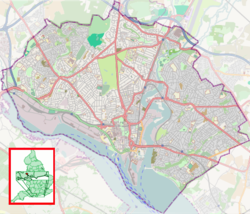Southampton Guildhall (branded the O2 Guildhall Southampton) is a multipurpose venue which forms the East Wing of the Civic Centre in Southampton, England. There are three venues in the Guildhall catering for various event formats: the Guildhall itself, the Solent Suite and a lecture theatre.[1]
 Exterior at night | |
| Former names | Southampton Guildhall (1937-2013) |
|---|---|
| Address | W Marlands Rd Southampton SO14 7LP England |
| Location | Civic Centre |
| Coordinates | 50°54′29″N 1°24′22″W / 50.908154°N 1.406003°W |
| Owner | Southampton City Council (operated by Live Nation UK) |
| Capacity | 1,749 |
| Opened | 13 February 1937 |
| Website | |
| www | |
History
editThe Guildhall, which was designed with a large portico with six Ionic order columns with pediment above, was intended to complement the rest of the Civic Suite and was opened by the Earl of Derby on 13 February 1937.[2] Internally, the principal room was the main hall which was 143 feet (44 m) long, 71 feet (22 m) wide and 38 feet (12 m) high.[2]
It contains a pipe organ, designed by John Compton, which was installed shortly before the opening of the building.[3][4] The organ is unusual in that it has two distinct consoles: a classical concert organ and a theatre organ.[3] The consoles share the same body of pipes which are housed in chambers above the proscenium arch.[3] At some 4,000 pipes it was also the largest organ ever made by Compton.[3][5]
The guildhall was used to accommodate French troops, who had escaped from France in June 1940 during the Dunkirk evacuation.[2] During the Southampton Blitz in November 1940, the Guildhall was damaged by a bomb that fell at the rear of the hall causing damage to the rooms behind the stage and killing one person. Another bomb penetrated into the basement below the stage before exploding. The building was also hit by numerous incendiary devices.[2] The Prime Minister, Winston Churchill, visited the guildhall during a tour of the city in January 1941[2] and it was used for high-level military conferences in spring and summer 1944 in anticipation of the Normandy landings which were coordinated from Southwick House.[2][6]
A new sprung floor was installed in the main hall in 1955 enabling the guildhall to become a major music venue.[2] Leading performers at the guildhall included rock bands, The Rolling Stones, in March 1964,[7] and The Who, in October 1971,[8][9] and singer-songwriter, David Bowie, in March 1972 during his Ziggy Stardust Tour.[10]
On 7 October 2013, the venue was renamed to the O2 Guildhall Southampton, reflecting a partnership between Live Nation UK and O2 Telefónica.[11]
See also
editReferences
edit- ^ "O2 Guildhall Southampton". Cevent. Retrieved 27 August 2019.
- ^ a b c d e f g "Southampton Civic Centre through the years". Southern Daily Echo. 21 February 2016. Retrieved 27 August 2019.
- ^ a b c d "Unique Compton pipe organ". Unique Compton pipe organ. Retrieved 10 December 2018.
- ^ "Southampton Guildhall". The Cinema Organ Society. Retrieved 23 August 2020.
- ^ "Second wind for Guildhall's organ". BBC. 4 December 2009. Retrieved 15 November 2020.
- ^ "How Southwick House was the unlikely springboard for D-Day". Yorkshire Post. 3 June 2019. Retrieved 15 November 2020.
- ^ "1964". Rolling Stones Database. Retrieved 23 August 2020.
- ^ "Southampton Guildhall". The Who Concert Guide. 18 October 1971. Retrieved 23 August 2020.
- ^ Neill, Andrew; Kent, Matthew (2009). Anyway, Anyhow, Anywhere: The Complete Chronicle of the WHO 1958–1978. Sterling Publishing Company. p. 303. ISBN 978-1402766916.
- ^ "The Ziggy Stardust Tour". David Bowie World. Retrieved 23 August 2020.
- ^ "Southampton Guildhall renaming 'cheapens' venue". BBC News Online. British Broadcasting Corporation. 7 October 2013. Retrieved 29 November 2013.
